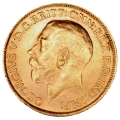Mintage: 360,000 (may include coins in sets)
Minted at The Sydney Mint
Below are some coins currently being offered on eBay. As an eBay Partner, We may be compensated if you make a purchase.
The Monarch is King George V. Prime Minister is David Lloyd George (Coalition). 1920 is MCMXX in Roman numerals. Treaty of Versailles takes effect, officially ending World War I. Later, rationing ends. The Council of the League of Nations meets for the first time in London (later becoming the UN). War Secretary Winston Churchill ends conscription and replaces with a volunteer army of 220,000 men. The British Empire, the largest empire ever in history, reaches its peak of 33 million square miles and a population of 423 million people. Women lecturers are given equal status to their males at the University of Oxford. The Imperial War Museum opens. In the 1920 Summer Olympics in Antwerp GB&NI win 15 gold, 15 silver and 13 bronze medals. The Metropolitan Police forms the Flying Squad, following their move from horses to cars. West Bromwich Albion win the Football League title for the first time and Aston Villa beat Huddersfield Town 1–0 in the first FA Cup Final since 1915. Rupert Bear cartoon first appears in the Daily Express. Meccano Ltd of Liverpool produce the first Hornby toy train, a clockwork 0 gauge model.
In USA
President is Woodrow Wilson (D-New Jersey). It is the start of the eras of Prohibition (1920–1933), Depression of 1920–21 (1920–1921) and Roaring Twenties (1920–1929). The 1920 United States Census shows a population exceeding 100 million, at 106,021,537. The NFL (National Football League) is founded. The US Post Office rules that children may not be sent via parcel post!
 George V was King of the United Kingdom and the British Dominions, and Emperor of India, from 6 May 1910 until his death in 1936 and was King during World War 1. George was the second son of Albert Edward, Prince of Wales (later King Edward VII), and grandson of Queen Victoria. After his death he was succeeded by his eldest son, Edward VIII.
George V was King of the United Kingdom and the British Dominions, and Emperor of India, from 6 May 1910 until his death in 1936 and was King during World War 1. George was the second son of Albert Edward, Prince of Wales (later King Edward VII), and grandson of Queen Victoria. After his death he was succeeded by his eldest son, Edward VIII. In 1919-20, the Silver price rose dramatically so .925 silver coins began to made in 0.500 siver. Gold Sovereigns were produced in large quantities early in George's reign - over 30 million in 1911 and again in 1912, although there was no bullion sovereigns issued 1918-1924 (Commonwealth mints did continue mintage).
Besides being minted in Britain, Sovereigns have been made in Australia (Melbourne, Sydney, Perth), India (then Bombay, now Mumbai), Canada (Ottawa) and South Africa (Pretoria) although these regional mints have not made sovereigns since 1932 (although India has produced some recently in a private mint partnership with the Royal Mint). The non-British coins carry a small mintmark ('S','M','P','I','C' or 'SA') just above the date. This 1920 Gold Sovereign Sydney was minted at The Sydney Mint.
The Obverse is the Monarch's head (George V) and the Reverse is most often St George and the Dragon, although other backs have been used and are of interest to collectors. The Reverse often gives the Sovs a new term, like "ShieldBacks".
Specifications for the Gold Sovereign
- Weight: 7.9881g
- Diameter: 22.05 mm
- Thickness: 1.52 mm
- Purity: 22 carat = 91.67% (11/12ths gold, 1/12th copper. Adding copper makes the coin more scratch and dent resistant)
- Gold Content: 113 grains = 7.3224 g = 0.2354 troy ounce
- Face value: £1 = 20 shillings
- Monarch: George V
History
Up until 1604 there was a coin called the English gold sovereign and in 1816 when there was the "Great Recoinage" the name was revived. At that time standard gold (22 carat) was valued at £46 14s 6d per troy pound; this meant a £1 coin needed to weigh 123.2744783 grains or 7.988030269 g. The weight is still the same today.
As a historical note: to maintain the Gold Standard, in 1816 the value of silver was set at 66 shillings for one troy pound and silver coins were only legal for denominations up to £2.
The first sovereigns carried the head of King George III and the famous George and the Dragon design by Benedetto Pistrucci (29 May 1783 – 16 September 1855), an Italian engraver who became chief medallist at the Royal Mint.
With high value coins such as the 1920 Gold Sovereign Sydney, collectors and bullion investors often worry about forgeries but actually gold coins are very difficult to forge due to gold's unique properties of density and colour. Gold is extremely dense and to use another metal and gold-plate it would result in a coin that is under-weight, over-diameter or half as thick, something that would be spotted very easily. More difficult to spot would be a bullion coin melted down and re-cast as a highly collectable date, but an expert can usually tell these too. You should always use reputable dealers.








